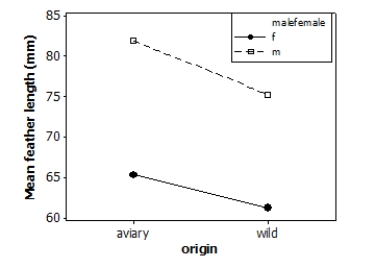Multiple Choice
Tail-feather length in birds is sometimes a sexually dimorphic trait. That is, the trait differs substantially for males and for females. Researchers measured tail-feather length (the R1 central tail feather, in mm) in male and female long-tailed finches either raised in an aviary or caught in the wild. This observational study does not have a balanced design, particularly because finches caught in the wild were more difficult to obtain. A total of 52 finches were studied.
A partial ANOVA table is provided below, along with an interaction plot displaying the group means.
S = 9.21600 R-Sq = 47.32% R-Sq(adj) = 44.03% The first step in analysis is to evaluate the interaction effect. Using a significance level of 0.05, what do the results suggest about interaction effect?
The first step in analysis is to evaluate the interaction effect. Using a significance level of 0.05, what do the results suggest about interaction effect?
A) Nonsignificant interaction effect; therefore, we can discuss the main effects separately.
B) Nonsignificant interaction effect; therefore, sex and origin do not influence mean tail-feather length in finches.
C) Significant interaction effect; therefore, we can discuss the main effects separately.
D) Significant interaction effect; therefore, we should discuss the main effects together.
Correct Answer:

Verified
Correct Answer:
Verified
Q5: Researchers are interested in the effects
Q6: A study examined the effect of
Q7: Tail-feather length in birds is sometimes
Q8: Does the environment affect bird weight?
Q9: Tail-feather length in birds is sometimes
Q11: A surgeon is interested in studying
Q12: Researchers are interested in the effects
Q13: A surgeon is interested in studying
Q14: A study examined the effect of
Q15: A study randomly assigned adult subjects